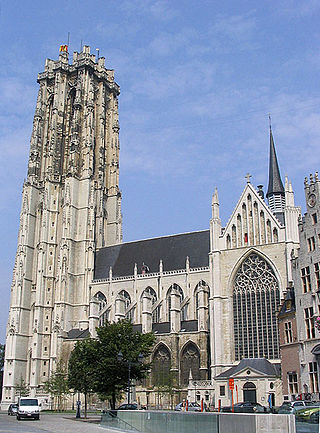
Sint-Martens-Lierde is a village which is part of the municipality of Lierde. It is located in the Denderstreek and in the Flemish Ardennes, the hilly southern part of the Belgian province of East Flanders.

St. Rumbold's Cathedral is the Roman Catholic metropolitan archiepiscopal cathedral in Mechelen, Belgium, dedicated to Saint Rumbold, Christian missionary and martyr who founded an abbey nearby. His remains are rumoured to be buried inside the cathedral. State-of-the-art examination of the relics honoured as Saint Rumbold's and kept in a shrine in the retro-choir, showed a life span of about 40 years and a death date between 580 and 655, while tradition had claimed 775 AD.

Saint Michael's Church is a Roman Catholic church in Ghent, Belgium, built in a late Gothic style. It is known for its rich interior decoration.

Erwetegem is a village and deelgemeente (sub-municipality) belonging to the municipality of Zottegem. It is located in the Denderstreek and in the Flemish Ardennes, the hilly southern part of the province of East Flanders, Belgium. Erwetegem used to be an independent municipality until 1970.

The Reger-Chor is a German-Belgian choir. It was founded in Wiesbaden in 1985 and has been conducted by Gabriel Dessauer in Wiesbaden. Since 2001 it has grown to Regerchor-International in a collaboration with the organist Ignace Michiels of the St. Salvator's Cathedral of Bruges. The choir performs an annual concert both in Germany and Belgium of mostly sacred choral music for choir and organ. Concerts have taken place regularly in St. Bonifatius, Wiesbaden, and in the cathedral of Bruges in its series "Kathedraalconcerten". The choir performed additional concerts at other churches of the two countries and in the Concertgebouw of Bruges.

Brabantine Gothic, occasionally called Brabantian Gothic, is a significant variant of Gothic architecture that is typical for the Low Countries. It surfaced in the first half of the 14th century at St. Rumbold's Cathedral in the city of Mechelen.

Saint Bavo's Cathedral, also known as Sint-Baafs Cathedral, is a Roman Catholic cathedral in Ghent, Belgium. The 89-metre-tall (292 ft) Gothic building is the seat of the Diocese of Ghent and is named for Saint Bavo of Ghent. It contains the well-known Ghent Altarpiece, also called the Adoration of the Mystic Lamb.
Jean d'Oisy (1310–1377) was the architect of several ecclesiastical buildings in Brabantine Gothic style. He was one of the earliest introducers of northern French Gothic style into the Low Countries and a teacher of the reputed Brabantian architect Jacob van Thienen.

Sleidinge is a village in the municipalities of Evergem in the province of East Flanders, Belgium. It is located about 10 kilometres (6.2 mi) north-west of Ghent.

St. Andrew’s Church is a Catholic church in Antwerp built in the 16th century. Its exterior is mainly characterised by a late-Gothic style while its interior is predominantly executed in Baroque style. It is the parish church of the Parish of St. Andrew’s. During the nineteenth century the St. Andrew's Parish was known as the parish of misery as it was by then mainly populated by poor people.

The Saint Laurentius Church of Ename was built shortly before the year 1000 by Herman, Count of Verdun. The only Ottonian building surviving in Ename, it is today the parish church of the village.
CornilCacheux was a French pipe organ maker.

The Campo Santo of Ghent, Belgium, is a famous Roman Catholic public burial ground in Sint-Amandsberg. The Campo Santo has been declared a historical monument by the government. This cemetery is located in the district of Dampoort.

The Great Beguinage of Sint-Amandsberg is an eight-hectare beguinage in the Sint-Amandsberg suburb, just outside the centre of Ghent, Belgium. It was built between 1873 and 1874 on the abandonment of the Old Saint Elisabeth Beguinage in the city centre. There is also a third beguinage in Ghent, that of Our-Lady Ter Hooyen.

The church of Our Lady, Melsele is a Roman Catholic parish church in Melsele, in the commune of Beveren, in East Flanders, Belgium. It is a registered heritage site.

Saint Ivo's College was a college at the Old University of Leuven that provided accommodation and facilities for poor students in the Faculty of Law. The founder was Robertus de Lacu, originally from Ghent, who had been professor of canon law since 1463. The college was dedicated to Ivo of Kermartin, the patron saint of lawyers, and was used by the law faculty for faculty meetings and ceremonies. The original library was destroyed by marauding Spanish soldiers in 1578, during the Dutch Revolt.

Saint Quentin's Church is a Roman Catholic church located at the Naamsestraat in Leuven, Belgium. Its exterior is mainly Gothic with a Baroque entrance portal. The interior contains Baroque choir stalls and altars. The church is named after the Saint Quentin, who is regarded in the Catholic faith as a protector against a wide range of contagious diseases.
The Major Seminary in Ghent was an institution for the training of Catholic clergy for the diocese of Ghent, first founded in 1569. It has been established at three different locations in the city. Since 2006 diocesan clergy from Ghent have been trained in Leuven.

Jacobus van Eynde or van den Eynde was a Flemish organ builder.

St Anthony of Padua Church or Rainbow Church is a Catholic church in Ghent, Belgium. It was constructed in Gothic Revival style in the years 1898–1900 to a design by architect Hendrik Geirnaert, as the parish church for the expanding 'Heirnis' section of the city. The new parish was established on 14 May 1896, but the Liberal majority on the local council initially opposed the building of a new church. The church was consecrated on 25 July 1901, by bishop Antoon Stillemans. The organ was built by Brussels organ maker Pierre Scheyven. It has been inventoried as built heritage since 1983.


















